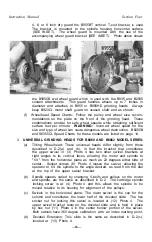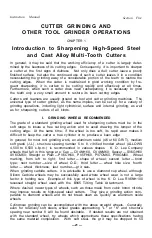
Instruction Manual
Section Five
III. RELIEF ANGLE (CLEARANCE)
A. Relief Angle:
Relief may be defined as the amount of stock removed from the teeth behind
the cutting edge to permit the teeth to cut freely and to clear the material
after the cutting edge has done its work.
It is important that the relief angle be correct. If it is insufficient, the teeth
will have a dragging cut, while if it is too great, the teeth will wear rapidly and
the cutter is likely to chatter Too much relief, however, is less objectionable
than too little, as under the former condition, the cutter will function, while
under the latter, it may not cut accurately.
The proper relief angle depends upon a number of factors, principally the type
and diameter of the cutter and the hardness of the material to be machined.
For example, cutters employed on soft materials like brass can stand more relief
than those employed on steel or cast iron. Likewise, the relief must be greater
for small cutters than for large ones. For these reasons, it is generally agreed
that the correct relief angle for a given cutter must be determined by experi
ence. Once the relief angle (AS WELL AS CUTTING SPEED AND FEED) that
gives the best results on a certain operation has been determined, it should be
recorded for future reference.
The general ranges of relief angles for typical tools and work materials are
shown in the table below.
*Smaller diameter cutters require larger relief angles.
B. Width of Land:
The land, which is the narrow surface immediately behind the cutting edge
that is ground to the relief angle, should be about 1/32 inch to 1/16 inch wide, de
pending upon the type and size of the cutter. As a result of repeated grinding,
the land may become so wide as to cause the heel of the tooth to drag on the
work. To control the width of the land, a clearance or secondary angle, usually
double the relief or primary angle, is ground as shown in Figure 13.
Relief on New Cutter
Figure 13-
—
Width of land increases with repeated sharpenings,
causing interference at A. Grind clearance angle as shown by
dotted line to control width of land.
—23—
Cutter
Tool
Material
Work Material
Steel
Cast
Iron.
Nonferrous
and
Nometallics
7° to 12º
5º to 10°
5° to 10°
2° to 7°
Peripheral
or
O.D. Cutting Edge
Side or End Cutting Edges
All
l ° t o 4° 1º to 4°
4° to 6°
4° to 6°
Cemented
Carbides;
Cast, Alloy
4° to 6°
4° to 6°
5° to 10°
5º to 10º
High Speed
Steel
Содержание B2000
Страница 14: ...Instruction Manual Section Three PHOTO 3 4 ...
Страница 24: ...Instruction Manual Section Four PHOTO 9 14 ...






























